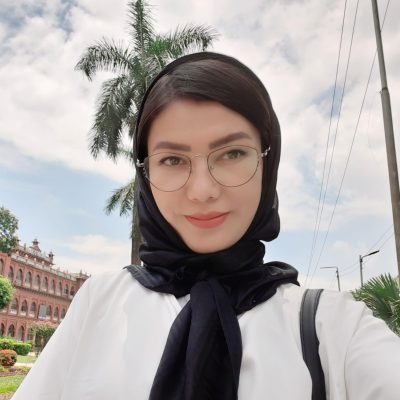Teaching and Learning with Technology
6 Writing Skills’ Instruction with Blended Learning Approach For K-12 Students
Sima Ahmadi and Arezo Sultani
Learning Objectives
This chapter outlines essential techniques and strategies for educational leaders (teachers, students, curriculum developers, heads of schools) to apply blended learning approaches and hybrid technologies to writing instruction. After reading the chapter, you will
- Be able to illustrate teaching methodologies of writing skills for K-12 school students
- Understand the process of structuring content in different genres of writing
- Get familiar with blended learning technologies that support writing instruction
Abstract
This chapter explores blended learning approaches and how to teach effective writing through this model to K-12 grades. It commences with an introduction to the definition of blended learning models, types of writing for students in schools, and methodologies to cater to learners’ writing skills through different approaches to blended learning. The chapter includes the analysis of several papers to explore the importance of writing skills in schools and conveying knowledge through blended classrooms. An overview of the result of other educators’ papers will be examined. Technologies and collaborative tools for students, student-center methodologies for different genres of writing, and K-12 students’ performance evaluation will elaborate on in detail. A substantial content of the chapter is gathered from books of a specialized professor in writing instruction for K-12, podcasts, and interviews with the writing instructors as well as those who are familiar with the field of blended learning.
Introduction
Effective writing is a crucial skill that can best prepare students for a successful career and university experience. In order to successfully express themselves, students require not only intellectual skills but also specific language and vocabulary expertise as well as suitable writing standards (Erkan & Sabah, 2011). This is an essential skill that students need to learn in order to be able to build effective non-verbal communication in schools and workplaces. According to research conducted by Sundeen in 2015, this has been revealed that writing has not been taken seriously in schools. Moreover, Casner-Lotto & Benners (2006) study as cited in Sundeen (2015) indicates a high rate of 80% of countrywide employers reporting that high school students are not skilled in effective writing. Many other studies show that writing has not been a curricular priority. Nevertheless, narrative assignments dominate in the early grades (Cutler & Graham, 2008). Whereas in the late years of school students are instructed to write short pieces related to learning content, not more than that, which will require pupils to think critically and synthesize ideas. This contradicts the types of writing students will need in their future education in that they are required to answer content questions, write summaries, and take notes. Students need to be familiar with different types of writing such as generating narratives, explanations, and reports, argumentative and procedural as well as writing research papers which never cover as efficaciously as they should be, particularly in developing countries schools. Analyzing the aforementioned arguments from multiple studies, it can be interpreted that a lack of teaching writing skills would adversely affect students in their academic and professional careers. Specifically in the 21st century in which almost all important communications take place through writing on digital platforms. Therefore, the student’s future success enormously depends on their ability to write.
In writing instruction, the teachers encounter challenges due to the inappropriateness of the curriculum, syllabus, concise teaching methodology, and time constraints of teaching. The lack of learning media and teaching strategies, the impropriety of teachers’ qualifications, and students’ negative attitude are other challenges. In October 2022, through an interview with Dr. Maria Brisk who is a specialized professor of writing instruction for k-12 at Boston College, she elaborates more about these challenges. She emphasizes that the great emergence of technology provides the opportunity for educational leaders to lay the foundation for a successful teaching methodology of writing for K-12 grades. As information technologies progress rapidly, educators can no longer prepare students without incorporating technology into their lessons. Educational leaders, principals, and teachers deal with how to integrate the use of technology in education in order to equip students with the best methods of learning. Blended Learning (BL) is one of the trends in modern education and has grown rapidly since Learning Management System (LMS) rise up in the late 1990s (Hunt, 2021). This is a combination of traditional classroom teaching methods with online learning to teach the same content in the same course to the same students through an LMS that students can access anytime and anywhere (Cleveland-Innes, 2018). Alrouji (2020) indicates that BL has captured the attention and interest of many researchers as a new approach for encouraging students in their learning process as an emerging trend in education. Consequently, the BL approach is an appropriate solution to address the indicated challenges of writing instructors in K-12 schools.
This chapter aims to provide information about BL’s different models and writing instruction through these models to K-12 school learners. Practical topics of various BL models, collaborative technologies, and tools, the importance of writing, the Teaching Learning Cycle (TLC), BL’s teaching methodologies, and students’ performance evaluation are the main subjects of the chapter. Professors from Boston College and Johns Hopkins University demonstrated writing instruction via BL models, challenges, solutions, and the methodologies of teaching writing skills to school students by this approach which has been included in this chapter as podcasts. It will provide educational leaders with an overview of teaching writing skills to secondary school students, an understanding of the processes of structuring content in different genres, and an understanding of blended learning technologies that support writing instruction. The chapter may serve as a useful resource to the curriculum developers, schools’ principals, teachers, and students in k-12 schools to grasp knowledge on the significance of academic writing skills, and the development of an updated writing curriculum. Ultimately, the successful delivery of these skills to learners by writing teachers that will lead to quality education.
BLENDED LEARNING AND ITS MODELS
Learning can now be done more easily and conveniently with greater flexibility by merging technology and considering Internet access and skill levels. Many teachers daily depend on technology in the classroom with things like computers, smart boards, presentations, and websites. The most straightforward definition of blended learning is the use of traditional classroom teaching methods together with the use of online learning for the same students studying the same content in the same class. Williams (2002) defines the term blended learning as the combination of face-to-face and online learning. Students in online learning experiences are not required to be physically together, but they should remain connected digitally through online communities. Furthermore, hybrid and mixed-mode learning are also terms used to describe blended learning. Teachers, programs, and schools differ in the design and implementation of these instructional systems in terms of how they use many types of teaching and learning experiences. Depending on how much technology is incorporated into instruction, blended learning can take many forms. In general, the blended learning model divides into four categories.
Figure 1) Models of Blended Learning (Blended Learning Definitions, 2018)
These BL models are used in different contexts with diverse audiences. As an example, the rotational model mostly uses for primary-grade learners. The Flex model uses in higher education and universities, and the Self-Blended model is used for school-age children and adults. Many research studies have demonstrated that blended learning designs contribute to improved learning outcomes for students (Li et al., 2020). In light of the importance of writing skills in the academic and professional era, BL models can apply in a certain context to build the students’ competencies in academic writing to remarkably improve the speed and efficiency of learning and teaching in schools.
Technologies and Tools used for collaborative writing
The blended learning tools could be generally classified into three groups: LMS tools, social networking tools, and synchronized tools. LMS are web-based tools that allow the creation, delivery, and evaluation of specific learning content. Facebook, WhatsApp, Twitter, Skype, and other social networking sites are utilized for debate and sharing educational content. The synchronized technologies that are freely available fall within the third group. Examples are Dropbox, Google Apps, and Zoho Apps. These internet services have enabled people with common interests to interact, share ideas, and work in novel ways (Rahman et al., 2020). Thus, encompassing these three groups of technological tools considering the availability and context can form an appropriate learning and teaching environment for the purpose of distance writing instruction.
Collaboration and interaction are critical parts of instruction in all subject areas. When students work together, they will learn efficiently with a high rate of eagerness. Due to this reason, in writing instruction students are strongly encouraged to work together in the various stages of different genres of writing. The below example will explain how to teach the “Deconstruction of Text” which is a critical stage in the writing of assorted genres (Brisk, 2014).
- The teacher illustrates the process of deconstruction of text in an online session.
- The teacher shares an electronic mentor text via Zoom or Google Meet with students.
- Students will divide into different rooms and read the text together.
- Teachers share a Google form or Nearpod where students can deconstruct the mentor text and insert it into a Graphic Organizer collaboratively.
- In the end, the teacher provides feedback on students’ work and both learners and teacher jointly deconstruct the text on the shared document.
According to Brisk (2014), students can understand the process of writing in different genres better because of cooperative work and use of the online tools for collaboration. Therefore, collaborative technologies and tools have a practical usage and profound impact on writing instruction in the blended learning context. This is because, with the use of collaboration technologies, students may meaningfully explore, share, interact with, and connect with other people and content (Lomas et al., 2008). Additionally, Barton and Klin (2011) argue that, in order to produce a single text with shared accountability and co-ownership, students engage in collaborative writing, which is characterized by interactions, meaning negotiation, and joint decision-making throughout the writing process. They also state that it has always been crucial to use collaborative learning in the classroom. By and large, This show that learning to write as a group can be a daunting and frustrating process, but social media tools can make a difference.
In the following podcast, Dr. Jeffrey Fink talks about what online collaborative tools can be used in BL’s writing instruction:
Podcast1) Collaborative digital technologies and online tools in writing instruction in K-12 schools
Below, some technologies and tools are specified, and their usage is explained. These tools allow students to work together remotely, although in some cases a collaboration tool is interchangeable with a communication medium or device. These tools and technologies are compatible with every context, and they already use in most learning environments.
Dr. Jeffrey Fink also suggested the below tools, applications, and websites that help students to work collaboratively and advance their writing skills.
- Google Docs: This is a Web-based document management application for creating and editing private and public, word processing and spreadsheet documents. Access to these files is available from any computer with an Internet connection and a fully-featured Web browser (Techopedia, 2017). Students can easily work together at the same time remotely on the same tasks.
- Cliché Finder: It is a free website that helps academics to find their overused words. This is not a collaborative tool, but teachers can introduce it to their students in order to find the redundant words in their writing. Though, if students only rely on these kinds of websites or other applications for writing, they may act passively, it would be helpful for them to know about technological tools that facilitate their writing.
- yWriter: A word processor that breaks a novel down into chapters and scenes helps you keep track of your work while leaving your mind free for creative expression. Students cannot count on it to write their novel for them, suggest plot ideas, or perform any creative tasks for them. Teachers and students can download yWriter for free and use it to write (www.spacejock.com, n.d.).
- Jamboard: Digital interactive whiteboard developed by Google. Teachers and students can use it easily for their group activities.
- Kahoot: This is a game-based learning platform used as educational technology. Teachers can use this application to assess the student’s performance and evaluate the class’s effectiveness.
- MS Forms: An online survey creator, part of Office 365, allows users to create surveys and quizzes with automatic marking.
- Nearpod: Nearpod helps educators make any lesson interactive, whether in the classroom or virtual.
- Poll Everywhere: Create simple surveys in minutes and let people vote. Turn feedback into actions.
- Miroboard: Miro is the online collaborative whiteboard platform that enables distributed teams to work effectively together, from brainstorming with digital sticky notes to planning and managing agile workflows (Beatty, 2019).
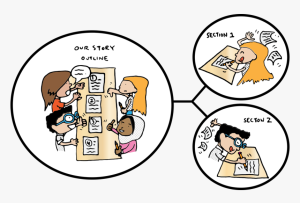
Students work together to write a story.
In an interview with Dr. Brisk in 2022, she suggests the following tools for teachers to use in distance learning to boost students’ interaction and communication in the learning and teaching process. As an example, she indicates that It is best to start with Google Classroom and then add other tools such as:
- Canva which is good for making graphic organizers, posters, and worksheets.
- Book creator which allows writing and illustrating books and even voice recording if students are too young or beginners English learners.
- Nearpod for asynchronous work and assessments is better than Seesaw, which can be linked to Zoom. Therefore, it can show the material and the face of the teacher. Allows for interactive activities.
- Edpuzzle teachers can make their own videos, and upload and annotate them. They also could upload a YouTube video of a read-aloud and annotate to deconstruct the text.
- Schoology is like Google Classroom and Canvas but friendly for K-12.
- Seasaw as a management system and communication with families.
Digital Collaboration Ideas for Distance and Hybrid Learning in the Secondary ELA Classroom, 2023 suggested below collaborative tools that assist learners in distance learning:
- Google Suite: The use of this tool in the secondary classroom makes collaboration digitally easy and versatile. Docs and Slides are probably the most popular choices for students.
- Office 365: It is possible for multiple people to collaborate on a Word document, Excel spreadsheet, or PowerPoint presentation using Microsoft 365 and OneDrive or SharePoint. Coauthoring is the process of having everyone work at the same time.
- Padlet: Notes can be added to a digital wall using a web application. It allows students to use digital gallery walks, share files, and post-digital projects. As an example, they can share their graphic essays on Padlet so that their peers can view and comment on them.
- Adobe Spark: This is a great online tool that is free. It allows students to work together to make informative videos. Nevertheless, it is only for asynchronous collaboration.
Importance of Writing Skills in Schools
Writing has been a means of extending human language across time and space since ancient times. Writing most likely developed due to political expansion in ancient cultures, which required dependable means for information transmission, account maintenance, historical record keeping, and related tasks. Writing is the most significant invention in human history, claims (Todd Carroll, 1990). It offers a reasonably permanent record of facts, information, viewpoints, convictions, emotions, arguments, justifications, theories, etc. Writing enables us to communicate with future generations and our contemporaries. It enables speakers from both the recent and distant past to communicate with us. In actuality, the drive to preserve cultural values and human spirituality gave rise to writing. It is a key component in the formal development of books, printed documents, and the internet. Additionally, we occasionally need to create formal texts in our daily lives for communication or other business-related reasons (Todd Carroll, 1990). Writing ability is our biggest ally in these situations. It is crucial to our daily lives. Let’s hear from professors about the significance of writing schools.
Podcasts 2) Dr. Maria Brisk and Dr. Jeffrey Fink elaborate on the importance of writing skills for school learners.
What is the importance of writing for students?
The student’s future success depends on their ability to write. When writing is introduced and practiced in schools with engaging activities, learners’ self-confidence will increase, and they will ultimately develop a passion for writing. Elementary students are required to learn writing skills in order to pursue studies in all academic subjects, communicate effectively, and express themselves (Yaser, 2021). Hence, it is highly recommended that teachers must teach the stages and processes of writing to their students technically because it will boost students’ capacity in numerous ways. Students will be able to organize their thoughts and develop their ideas, and importantly, their critical thinking skills of them will be improved. There are other crucial reasons that K-12 students must be familiar with effective writing. An article about the importance of writing skills (2022) and another study from Yaser (2021) bold the following points as the importance of writing skills for students in school.
- Effective writing improves communication skills: The ability to communicate both orally and non-verbally is an essential skill that every student must master in order to succeed in academics as well as in life overall. A student’s communication skills can be significantly improved through writing, which is why writing has been deeply incorporated into the school curriculum as a way to significantly improve their communication skills. Using the language provided by writing, students can better organize their ideas and learn all the rules of the language. When we learn how to use writing as a means of expressing our ideas and messages in a clear and direct manner to our listeners, we can also improve our skills in grammar and spelling, punctuation, gestures, paralinguistics, etc.
- Effective writing sharpens creativity and imagination levels: According to research, we are all intrinsically creative. Certain parts of our brain are stimulated when we write, particularly what is known as the “frontal cortex,” the part of the brain widely recognized as the source of creativity. Therefore, the more we write, the more our entire brain functions to come up with innovative ideas that may be used to address difficulties in real life. Students can create ideas, think about them, and then put them in opposition to one another to create new, creative methods to explore the world around them and to make the best of whatever circumstance they are in.
- Writing skills widen knowledge base: Students’ knowledge to learn can be significantly increased by writing. They must have been able to read before they become proficient writers. As we are all aware, writing frequently necessitates extensive research, often into topics we are unfamiliar with. Students broaden their knowledge base and improve their memory skills as they write more and, of course, conduct more research. Throughout this process, they will gain an understanding of what has happened in the past, what is happening now, and how they can actively influence future situations with their actions today.
- Effective writing is vital to academic success: Students’ academic success relies heavily on their writing capabilities, which are one of the most important requirements for earning excellent grades and earning a good degree. This is why students employ good essay writing services, which they must have found on review sites, for their essay assignments and other key academic duties.
- Writing skills improve the level of students’ confidence: Writing can increase students’ level of confidence, as well as their sense of achievement. For instance; when a student completes his/ her essays and other writing assignments, she/he feels a strange sense of accomplishment that she/he has successfully exploited his/her literary skills. Indeed, this will give them more confidence to assert their opinions more expressly, especially in the public.
Based on Klimova (2012), writing is significant since it is utilized frequently in both higher education and the workplace. Students will not be able to communicate effectively with professors, employers, peers, or just about anyone else if they don’t know how to express themselves in writing. Proposals, memoranda, reports, applications, first interviews, emails, and more are all common forms of written professional communication that college students and successful graduates use on a regular basis.
BLENDED TEACHING METHODOLOGIES FOR WRITING SKILLS
As part of a blended writing class, students have to use computers to engage in self-paced learning. In a study by Cui and Hu (2018) states that to produce meaningful output with each other, students should meet their teachers in the classroom where real-life situations are created. Students’ online writing quality will be checked by teachers through guidance and feedback. Furthermore, students are inspired to attend a variety of extracurricular writing activities. The formation of peer writing groups within a class enhances student-to-student interaction, leading to numerous benefits for student learning (Cui & Hu, 2018).
The below video guides teachers on how to teach interactive writing skills to school children in a hybrid classroom.
Students must complete computer-based, autonomous learning using computers as part of their blended writing class (Cui & Hu, 2018). The instructor and students should interact in the classroom, where authentic settings are provided for them to collaborate on productive outcomes. Teachers will offer suggestions and criticism to evaluate the caliber of their students’ online writing. Students are also urged to take part in a variety of extracurricular writing activities. Within a classroom, the formation of peer writing groups enhances the value of student-student interaction and has a number of positive learning effects (Cui & Hu, 2018).
- Computer-based autonomous learning: students must complete the autonomous writing tasks in a computer-based environment.
- Face-to-face classroom instruction: After completing sufficient online writing activities, students should meet with their teachers once a week to write about what they have learned online in order to communicate honestly in everyday settings.
- Peer learning in extracurricular writing activities: King (1999) maintains that peer learning is an educational practice in which students interact with other students to attain educational goals.
In this approach with the help of a platform, in traditional offline sessions, students read, retell, discuss, write essays, outline texts, respond to questions, create projects related to their scientific path, translate newspaper and magazine articles in accordance with their area of expertise, and view movies. They also perform a few more particular jobs. With the assistance of the online platform, they continue their classwork at home (King, 19999, pp.87-115).
systematic Functional Linguistic Genre Pedagogy
The study of Systematic Functional Linguistics examines the relationship between language and its functions in social settings. There are three linguistic strata in SFL: meaning (semantics), sound (phonology), and wording (syntax, morphology, and lexis). Moreover, the term genre in Systematic functional Linguistic Genre Pedagogy (SFL GP) is believed to be text types and refers to “the methods that we get things done through language – the ways that we exchange information and knowledge and interact socially” (Martin & Rose, 2008). SFL GP was primarily created in Australia (Emilia & Hamied, 2015). Language is considered a meaning-making resource and systemic functional linguistics emphasize the interrelationship of form and meaning.
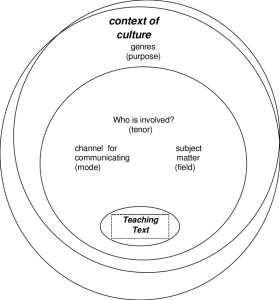
Pre-writing, writing, and post-writing are the three stages of the productive mastery of writing. During the pre-writing phase, students gather information and develop a topic outline. They engage in a variety of writing-related tasks throughout this stage, such as story-telling, reporting, writing letters, and writing paragraphs. Teachers review students’ writing after they have finished it and offer suggestions for improvement (AlSmari, 2019). Writing can take many different forms. The basic unit of structure in writing that consists of more than two sentences is the paragraph, which is one of them. A topic sentence, supporting information, and a conclusion make up its three essential components. It is possible to use a variety of paragraph types, including narrative, explanation, report, argumentative, and descriptive ones (Kartawijaya, 2018). In the following episode, Dr. Brisk goes into greater detail about the meaning and application of SFL and TCL.
Podcast 3) Definition of Systematic Functional Linguistic and Teaching Learning Cycle
Types of Writing Assignments
Learners do not move in a straight line while writing. At some point during the writing process, students can go back and double-check their thoughts. Therefore, the writing process is a repetitive one and students are encouraged to organize their ideas to produce writing that is balanced (Yılmaz and Erkol, 2015). The common core standards of writing are divided into three types of writing. The below graphic organizer declares these three types of writing and each has been divided into more categories.
Figure 2) Common Core State Standards are divided into three categories of writing (Brisk, 2014)
According to the Common Core State Standards (CCSS), narratives, informational/explanatory texts, and argumentative texts are the three broad text categories. As the report and explanation are explained in the above graphic organizer, the below tables clarify different types of report and explanations, their purpose, and examples for each type. Teachers are responsible to teach each of these types to the learners according to the steps illustrated in the TLC.
Types of Reports:
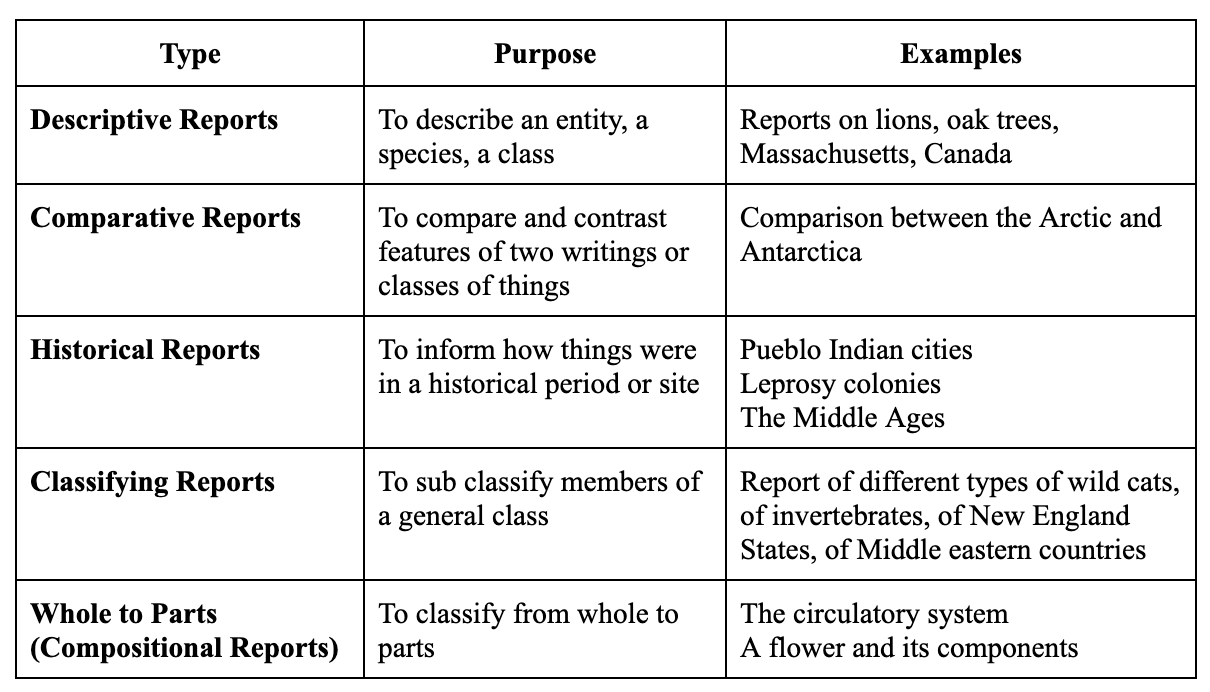
Types of Explanation:
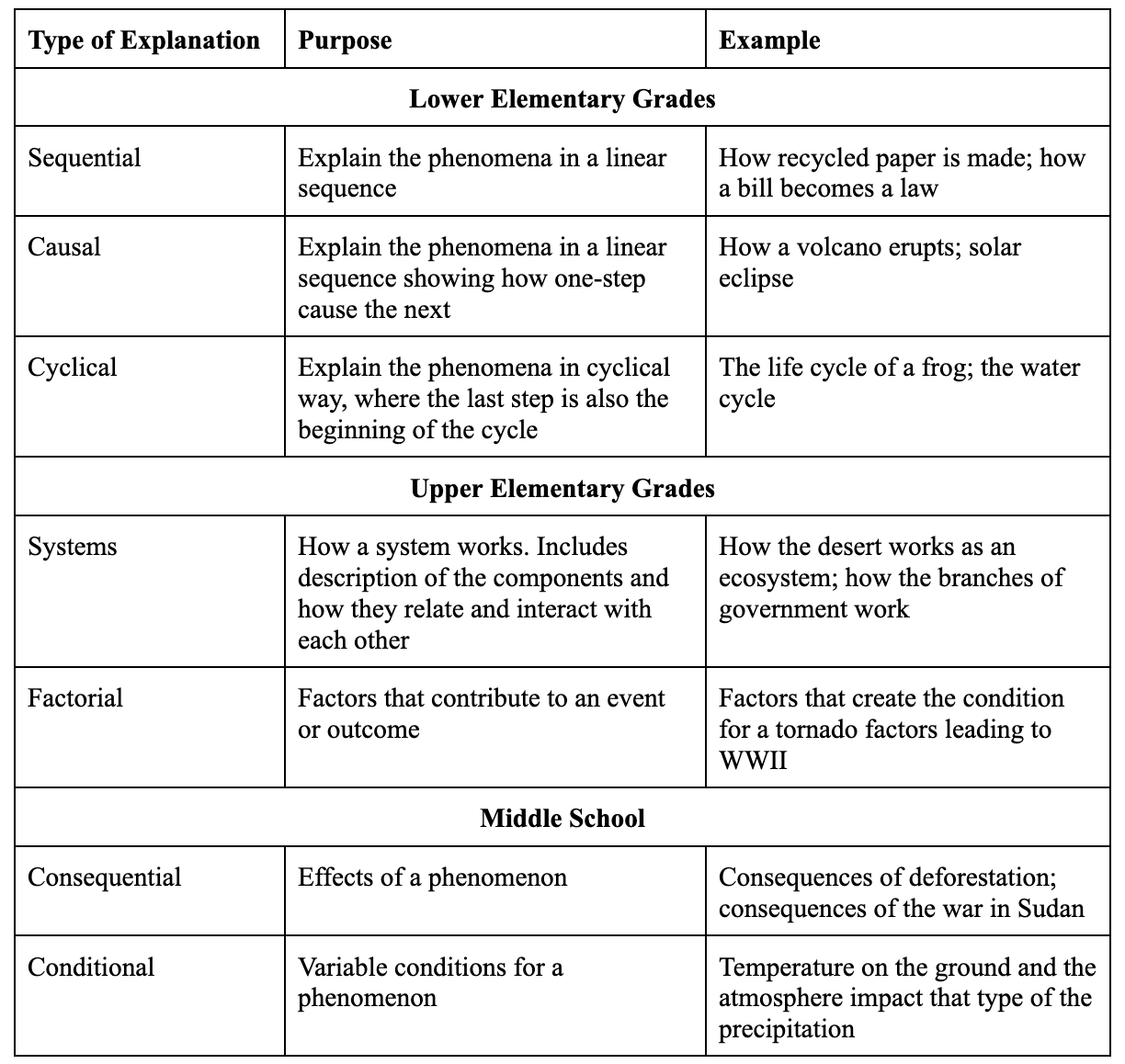
Teaching Learning Cycle (TLC) of different Genres of writing
The Teaching and Learning Cycle (TLC) is a method of writing instruction that encourages student writing through four stages: deconstruction of texts shared production of texts, independent construction of texts, and negotiations of fields or expanding content knowledge (Brisk, 2014).
The TLC idea was first developed in Australia (Martin & Rose, 2008) and later used in writing and teaching research for English language learners, both those learning the language as a first language (L1) and those learning it as a second language (ESL), proving that it is a successful strategy (Burns, 1990; Hammond & Hood, 1990). It is a method of writing instruction that encourages student writing through four stages: deconstruction of texts shared production of texts, independent construction of texts, and negotiations of fields or expanding content knowledge (Brisk, 2014).
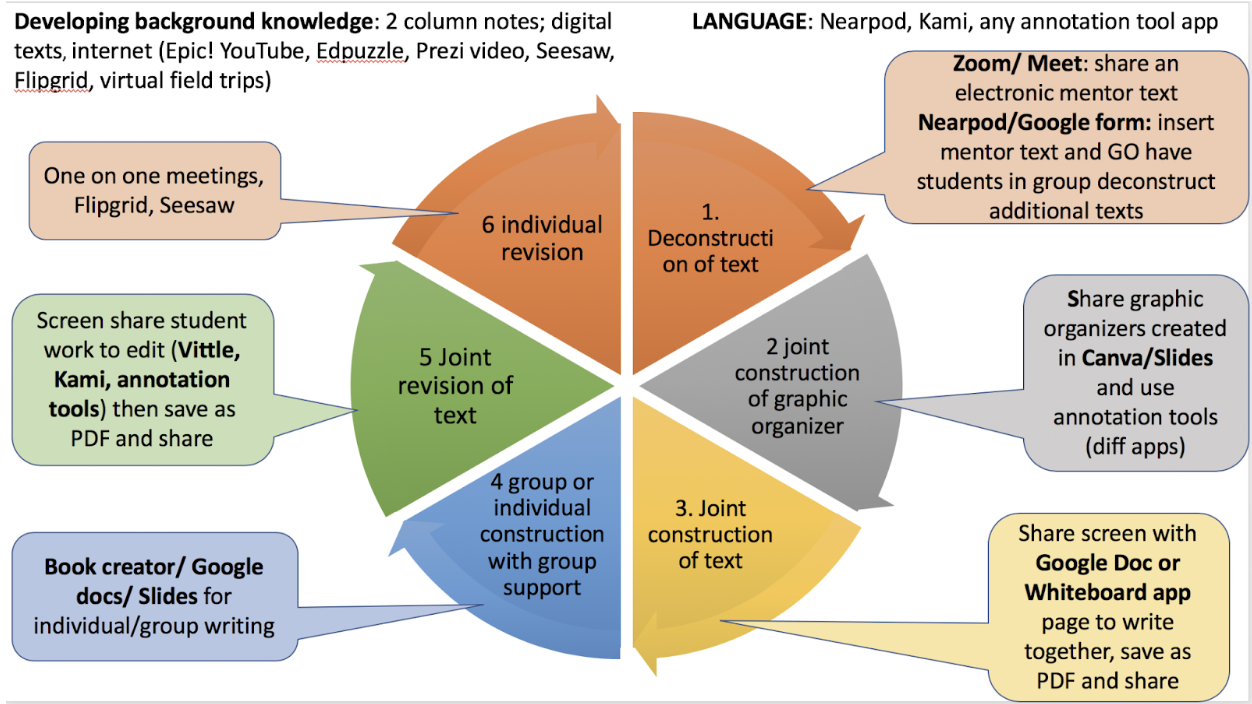
Applying the TLC in writing instruction especially when it is remote teaching can profoundly help students to learn effective academic and professional writing. Teachers need to be careful to observe all activities that need to be done in each step of different genres of writing.
The New Learning Online website declares the teaching writing cycle involves at least four crucial stages.
- Tapping into students’ interest and building up field knowledge in the subject
- Modeling examples of the text
- Joint negotiation and construction of the text
- Independent construction which students write on their own.
All these four steps are practically explained and worked on in the below video.
Illustration 2) Practical teaching of writing steps for primary-grade students (The Teaching-Learning Cycle – New Learning Online, n.d.)
Dr. Maria Brisk and Dr. Jeffrey Fink talk about the impact of blended learning in writing instruction in schools, the pros, and cons of this method, and what techniques teachers need to take into consideration to increase the efficacy of writing instruction in the context of blended learning.
Podcast 4) Impact, Pros, and Cons of BL on writing instruction in K-12 school
Effectiveness of writing instruction through BL for students
According to Cui and Hu (2018), students can think creatively and complete new assignments in an online setting. Depending on their preferences, individuals can focus on the more challenging material to achieve a higher grade or acquire the material more quickly. Those who have trouble understanding the material may learn it beforehand and meet the lesser standard. Due to the fact that all of the contents are accessible through the LMS, they can spend more time learning them for a thorough and deeper grasp. Moreover, students do not need to be stressed out about missing classes. On the other hand, blended learning is important for students’ classroom learning. Not all students are adept at using technology online. They struggle against the multimedia setting. System problems are sometimes unavoidable due to internet difficulties. Interaction in the classroom allows students to demonstrate their knowledge and acquire skills. In this study, the author conducted interviews and observed students’ writing performance before and after implementing blended learning methods. The outcome demonstrates that pupils can perform better than ever before if given enough respect and rights. The interviews’ findings revealed that “it’s not difficult to see why most students choose to use the BL technique instead of traditional education to practice writing in the questionnaire, and why students may make such great progress following the application.” (Cui & Hu, 2018). Hence, we can conclude that applying the blended learning techniques boosts students’ writing skills as well as their collaboration abilities.
The interview result reveals by implementing BL approaches, students were able to improve their autonomous writing abilities and usage of different strategies in their writing. Additionally, other skills such as group work, monitoring the writing process, and evaluating their writing results enhance their group performance. It also supported them in deciding the most appropriate writing techniques for themselves. Cui and Hu (2018) argue that the majority of students retained the idea that the novel BL approach assisted them to expand their writing potential more than the teacher-centered model, developing their team spirit, and enhancing their writing ability.
As every teaching modalities have its own challenges and teachers use a variety of strategies to overcome those challenges. Let’s hear from Dr. Brisk about the challenges of writing instruction via blended learning settings and how to address effectively these obstacles.
Podcast 5) Challenges of writing instruction through blended learning for K-12 students
Rahman et al. (2020), believe that the blended learning method, which enriches assistance, activities, sources, and resources with a clear set of guidelines and planning, is a promising, imaginative, and practicable innovation in expanding their learning experience. Students learn how to exchange written material, explain, and clarify feedback on their learning task through blended learning. However, the idea of blended learning seeks to enhance rather than replace the teacher’s function in the educational process. By exchanging written content and providing access to a variety of online reading materials, blended learning can help ESL students improve their writing abilities. After examining the impact of blended learning on students’ writing abilities, Sri Wahyuni, (2018) states, the results of the student’s writing in the pre-test and post-test were clearly different, which was a hint that blended learning was very effective. It was evident that blended learning improved the writing skills of the experimental group’s members since they outperformed the control group on the post-test. Many of the students were able to become more metacognitively aware of their English writing process because of blended learning.
Evaluating Learner Performance
Learning takes place in students’ thoughts, which are invisible to the outside world. Hence, it is necessary to assess students’ learning using their performance, or what they can do with what they have learned. Students’ performance can be evaluated through assessments that are formal or informal, high- or low-stakes, individual or communal, private or public, etc. Studies on the effects of BL on student performance in a range of contexts, such as higher education, adult education, and workplace training, have been conducted. The findings indicated that BL has a favorable effect ( Vo et al., 2017). Alhaji (2020) specifically looked at how effectively blended learning improved the written English communication skills of Saudi female students, and how pleased they were with the method of instruction. The findings demonstrate that in the English writing course, blended learning reduces stress while promoting engagement and communication. Similar to this, Keshta and Harb (2013) used an experimental approach to investigate the effectiveness of blended learning in teaching English writing to students in Palestine. The study found that students’ writing skills are considerably improved via blended learning. Let’s hear from Dr Brisk and Dr. Fink about the evaluation process of class and students in the following podcast:
Podcast 6) K-12 Students’ performance and progress assessment in the teaching of writing skills via BL
The research has shown, the BL participants outperformed the face-to-face writing course participants in the post-test, scoring higher. Following blended learning training, the student’s written English writing course results revealed that they had improved in terms of organization, grammar, structure, content, vocabulary, and spelling. Instead, of relying solely on direct instruction, BL encouraged students to practice English writing independently.
Language teachers believe that the following BL characteristics could explain why experimental kids performed better:
- The various learning styles of the pupils were addressed by exposing them to various activities such as methods and multimedia, audio, texts, animation, videos, and PowerPoint slides.
- Fostering ongoing interactions between students and teachers, improving communication, cooperation, and teamwork, as well as encouraging active engagement, all of which boosted motivation and interest in learning.
- Continuous feedback was provided to show how well students were learning.
- Assisting students in creating self-learning strategies promoted independent learning.
- Enhancing students’ information and communication skills through their engagement with educational materials, self-evaluation tools, and informational search and training opportunities empowered students to meet learning objectives.
Conclusion
Writing is one of the most essential communicative language skills that start from making sentences and binding them in a meaningful and communicative context. Therefore, teaching writing skills becomes one of the major concerns in any educational system around the world. It is, also, a means of communicating ideas, thoughts, and emotions evidently and effectively through the proper use of grammar rules (Reinares Martínez et al., 2021). In essence, with the vast emergence of technologies, educational practitioners are seeking to substitute the modern system of delivering education with the integration of technologies to blend the advantages of traditional teaching and online teaching. Through this modality, the learning process will be more productive rather than in solely traditional classrooms because it uses diverse strategies that positively impact advancing students’ innovations, motivations, involvement in classroom activities, and flexibility in attending classes online or offline and consequently raising learning outcomes.
In summary, blended learning dramatically enhances students’ writing abilities. The focus on interactive, adaptable, and dynamic learning activities in blended learning is part of its effectiveness. With the help of the blended learning technique, students can easily access learning materials and engage in collaborative conversations with peers and teachers. Therefore, blended learning has the potential to enhance student learning outcomes and encourage independent learning if correctly applied. However, the blended learning approach only modifies the role of the instructors as facilitators in the combined environment of teaching and learning, not their primary job. The blended learning model has essentially been shown to be successful, but its adoption necessitates the combined efforts of governments, educators, institutions, and pertinent authorities. This is due to the fact that the blended learning environment is fraught with difficulties, including inadequate staff training, low student technological proficiency, expensive internet costs, unreliable connectivity, and administrative problems. Our chapter could deepen our understanding of how the blended learning strategy enhances students’ writing abilities. By delivering an enjoyable learning experience and a welcoming educational atmosphere, blended learning has been shown to be a promising, imaginative, and practical new option for both students and instructors. The information in this chapter might be useful to educators, students, educational leaders, governments, and other relevant authorities in deciding on a suitable strategy for teaching and instructing writing in higher education. Additionally, this chapter offers helpful knowledge that can be applied when creating curricula, particularly at the secondary school level.
Instructors are urged to implement the strategies and tools which elaborate on the content of the chapter in their classrooms to expand student skills of writing and promote their critical thinking, communication, interaction, and engagement in the blended learning setting. Blended learning and its models, collaborative technologies and tools, blended teaching and learning methodologies, SFL and TLC, and class evaluation techniques are the topics that directly aid teachers in successfully applying blended teaching of writing in their classrooms. The content of this chapter has been gathered from academic journals, papers, videos, students’ reflections, and interviews with university professors who are experts in blended learning and instruction of writing skills for school teachers and learners. The information is presented through text, a genially web-based tool, tables, pictures, and informative videos that make the chapter very user-friendly. This chapter provides general information that can be applied in varied sorts of learning centers, both private and public schools.
Lets listen to the chapter podcasts in anchor by spotify
Podcast 01: Dr. Maria Brisk talks about writing instruction for K-12 learners in a blended learning environment.
- Episode 01: Importance of Writing Skills in K-12 Schools
- Episode 02: Impact, Pros, and Cons of Blended learning in Writing Instruction
- Episode 03: SFL and TLC Definition
- Episode 04: Challenges of Writing Instruction via BL
- Episode 05: Students’ Performance Evaluation in BL Setting
Podcast 02: Dr. Jeffery Finks talks about writing instruction for K-12 learners in a blended learning environment
Recommended readings
The below resources will help readers to have precious information on how to enhance their writing skills and how to teach the skills to the schools’ learners
- Dr. Maria Brisk’s online courses about teaching writing for K-12 schools
- Engaging Students in Academic Literacies
- Framework for Success in Postsecondary Writing
- Blended Learning Models
- How to Teach writing skills in online and hybrid classrooms
- WRITING NEXT- Effective Strategies to Improve Writing of Adults in Middle and High School
- Teaching Writing via TLC model
Review Questions
- How you can establish a blended learning environment for your context?
- Which collaborative technologies did you find helpful for students’ communication, interaction, and collaboration?
- What do you learn from the podcasts of professors?
- In the video from the Institute of Education Sciences regarding Interactive Writing Instruction Online with Young Children, which strategies did the instructor use to help students to write a collaborative letter?
- What are the Teaching Learning Cycles and how it helps teachers and students in the teaching and learning process?
receiving A badge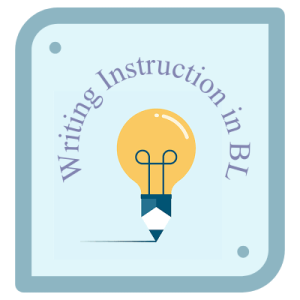
Here you can receive your badge after completing the chapter assessment.![]()
Key terms(Glossary):
- Asynchronous Learning: Asynchronous learning means that learning takes place at all different times for students enrolled in a course.
- Bichronous Learning: synchronous online learning is the blending of both asynchronous and synchronous online learning, where students can participate in any time, anywhere learning during the asynchronous parts of the course but then participate in real-time activities for the synchronous sessions.
- Dynamic Content: Dynamic content is defined as any digital or online content that changes based on data, user behavior, and preferences. This can be text, audio, or video format content.
- Flipped Classroom: The flipped classroom is a two-part student-centered learning strategy that includes individual computer-based instruction outside of class and interactive learning activities during class.
- Genres: Genre is the organization of literature into categories based on the type of writing the piece exemplifies through its content, form, or style.Hybrid learning: Hybrid learning is an educational model where some students attend class in person, while others join the class virtually from home.
- Learning Management System (LMS): LMS is a software system designed to facilitate administrative tasks as well as student participation in e-learning materials.
- Synchronous Learning: Learning and teaching in which distant students attend in-person classes using synchronous rich-media tools like video conferencing, web conferencing, or virtual worlds.
- Systemic Functional Linguistics (SFL) Genre Pedagogy: Theoretically, systematic functional linguistics (SFL) examines how social settings and language features relate to one another (Halliday & Matthiessen, 2014).
- The Teaching and Learning Cycle (TLC): is a method of writing instruction that encourages student writing through four stages: deconstruction of texts shared production of texts, independent construction of texts, and negotiations of fields or expanding content knowledge (Brisk, 2014).
- Traditional Classroom: A traditional classroom is an educational place where the teacher delivers knowledge to the students in person without any third-party medium.
- Word processor: A word processor is a type of software application used for composing, editing, formatting, and printing documents.
- Deconstruction of Text: Deconstruction is the process of removing the structure of a teacher’s writing in order to properly understand the text.
- Mentor Text: Mentor texts are written pieces that serve as good writing examples for student writers.
- Common Core Standards: a set of educational standards for teaching and testing English and mathematics from kindergarten to 12th grade in the United States.
Reference
- Alrouji, O. (2020, August 18). The Effectiveness of Blended Learning in Enhancing Saudi Students’ Competence in Paragraph Writing | Alrouji | English Language Teaching | CCSE. Retrieved October 9, 2022, from https://www.ccsenet.org/journal/index.php/elt/article/view/0/43515
- Alsmari, N. A. (2019). Fostering EFL Students’ Paragraph Writing Using Edmodo. English Language Teaching, 12(10), 44. https://doi.org/10.5539/elt.v12n10p44
- Barton, M., & Klint, K. (2011). A student’s guide to collaborative writing technologies. Writing spaces: Readings on writing, 2, 320-32.
- Blended Learning Definitions. (2018, March 9). Christensen Institute. https://www.christenseninstitute.org/blended-learning-definitions-and-models/
- Brisk, M. E. (2014, July 25). Engaging Students in Academic Literacies | Genre-based Pedagogy for K- [Video]. Taylor & Francis. https://www.taylorfrancis.com/books/mono/10.4324/9781317816164/engaging-students-academic-literacies-mar%C3%ADa-estela-brisk
- Challob, A. I., Bakar, N. A., & Latif, H. (2016). Collaborative Blended Learning Writing Environment: Effects on EFL Students’ Writing Apprehension and Writing Performance. English Language Teaching, 9(6), 229. https://doi.org/10.5539/elt.v9n6p229
- Cleveland-Innes, M. (2018, November 1). Guide to Blended Learning. https://oasis.col.org/handle/11599/3095
- Cui, G., & Hu, J. (2018). Experimental Study to Develop Writing skills through Blended Learning in the Times of Internet+. MATEC Web of Conferences, 246, 03031. https://doi.org/10.1051/matecconf/201824603031
- Cutler, L., & Graham, S. (2008). Primary grade writing instruction: A national survey. Journal of Educational Psychology, 100(4), 907–919. https://doi.org/10.1037/a0012656
- Digital Collaboration Ideas for Distance and Hybrid Learning in the Secondary ELA Classroom. (2023b, January 2). The Secondary English Coffee Shop. https://secondaryenglishcoffeeshop.blogspot.com/2020/07/digital-collaboration-secondary-ELA.html
- Emilia, E., & Hamied, F. A. (2015). SYSTEMIC FUNCTIONAL LINGUISTIC GENRE PEDAGOGY (SFL GP) IN A TERTIARY EFL WRITING CONTEXT IN INDONESIA. TEFLIN Journal – a Publication on the Teaching and Learning of English, 26(2), 155. https://doi.org/10.15639/teflinjournal.v26i2/155-182
- Erkan, D. Y., & Saban, A. I. (2011). Writing performance relative to writing apprehension, self-efficacy in writing, and attitudes towards writing: A correlational study in Turkish tertiary-level EFL. The Asian EFL Journal Quarterly, 13(1), 163-191.
- Hammond, J., Burns, A., Joyce, H. Brosnan, D., Gerot, L., Solomon, N. & Hood, S. (1992). English for social purposes: A handbook for teachers of adult literacy. Sydney: National Centre for English Language Teaching and Research, Macquarie University, Australia.
- Hunt, V. (2021, May 12). Pros And Cons Of Blended Learning At College. eLearning Industry. Retrieved October 15, 2022, from https://elearningindustry.com/pros-cons-blended-learning-at-college
- Institute of Education Sciences. (2020, November 13). Interactive Writing Instruction Online with Young Children [Video]. YouTube. https://www.youtube.com/watch?v=F64fcdzbEYk
- Kartawijaya, S. (2018). Improving Students’ Writing Skill in Writing Paragraph through an Outline Technique. Curricula, 3(3). https://doi.org/10.22216/jcc.2018.v3i3.3429
- Keshta, A. S., & Harb, I. I. (2013). The effectiveness of a blended learning program on developing Palestinian tenth graders’ English writing skills. Education Journal, 2(6), 208-221. doi: 10.11648/j.edu.20130206.12
- King, A. (1999). ‘Discourse patterns for mediating peer learning.’ In A. M. O’Donnell & A. King (Eds.), Cognitive perspectives on peer learning (pp.87-115). Mahwah, NJ: Erlbaum.
- Klimova, B. F. (2012). The Importance of Writing. Paripex – Indian Journal of Research, 2(1), 9–11. https://doi.org/10.15373/22501991/jan2013/4
- Langston, A. (2021, February 22). The Self-Blend Model of Blended Learning Explained. ViewSonic Library. https://www.viewsonic.com/library/education/the-self-blend-model-of-blended-learning-explained/
- Li, K. C., Tsang, E. Y. M., & Wong, B. T. M. (2020, September 30). Innovating Education in Technology-Supported Environments (Education Innovation Series) (1st ed. 2020). Springer.
- Lomas, C., Burke, M., & Page, L. (2008). Collaboration Tools. EDU CAUSE Learning Initiative, 2, 11. https://creativecommons.org/licenses/by-nc-nd/3.0/
- Martin, J. R. & Rose, D. (2008). Genre relations: Mapping culture. London: Equinox.
- Rahman, A. M., Azmi, M. N., & Hassan, I. (2020). Improvement of English writing skills through blended learning among University students in Malaysia. Universal Journal of Educational Research, 8(12A), 7694-7701. https://doi.org/10.13189/ujer.2020.082556
- Reinares Martínez, I., Evan, S., Wienhold, F. G., Brioude, J., Jensen, E. J., Thornberry, T. D., Héron, D., Verreyken, B., Körner, S., Vömel, H., Metzger, J., & Posny, F. (2021). Unprecedented Observations of a Nascent In Situ Cirrus in the Tropical Tropopause Layer. Geophysical Research Letters, 48(4). https://doi.org/10.1029/2020gl090936
- Study.com | Take Online Courses. Earn College Credit. Research Schools, Degrees & Careers. (n.d.). https://study.com/academy/lesson/flex-mode-in-blended-learning-definition-application-examples.html
- Sundeen, T (2015). Writing Instruction for Adolescents in the Shadow of the Common Core State Standards. Journal of Adolescent & Adult Literacy, 59b(2), 197-206. http://www.jstor.com/stable/44011240
- Techopedia. (2017, January 11). Google Docs. Techopedia.com. https://www.techopedia.com/definition/13626/google-docs
- The Rotation Model. (n.d.). https://www.readinghorizons.com/literacy-articles/blended-reading-approach/models/rotation-model
- Todd Carroll, R. (1990). Student Success Guide. https://www.skepdic.com
- Vo, H. M., Zhu, C., & Diep, N. A. (2017). The effect of blended learning on student performance at course-level in higher education: A meta-analysis. Studies in Educational Evaluation, 53, 17-28. https://doi.org/10.1016/j.stueduc.2017.01.002
- Wahyuni, S. (2018). The Effect of Blended Learning Model towards Students’ Writing Ability. J-SHMIC : Journal of English for Academic, 5(2), 97–111. https://doi.org/10.25299/jshmic.2018.vol5(2).1801
- Williams, C. (2002). Learning on-line: A review of recent literature in a rapidly expanding field. Journal of Further and Higher Education, 26(3), 263-272.
- www.spacejock.com. (n.d.). Website for Simon Haynes, Author and Programmer. http://www.spacejock.com/yWriter5.html
- Yaser, A. (2021, July 31). The effect of using a word processor in teaching writing skills among secondary students in schools in Jordan. Educational Research and Reviews, 16(7), 272–278. https://doi.org/10.5897/err2019.3757
- Yılmaz, C. & Erkol, K. (2015). Using word processor as a tool to enhance the teaching of writing in a Turkish EFL context: An action research / Türk EFL bağlamında yazma öğretimini iyileştirme aracı olarak kelime işlemci kullanımı: Bir eylem araştırması . Eğitimde Kuram ve Uygulama , 11 (1) , 346-358 . Retrieved from https://dergipark.org.tr/en/pub/eku/issue/5464/74167
